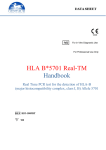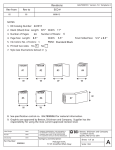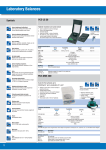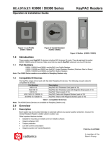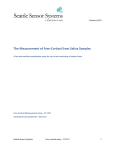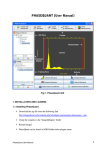Download Cortisol - B-Bridge International, Inc.
Transcript
B-Bridge International, Inc. Cortisol Enzyme Immunoassay Kit User Manual Catalog # K3003-1 K3003-5 K3003-W1 K3003-W5 1 Strip Plate Kit 5 Strip Plate Kit 1 Whole Plate Kit 5 Whole Plate Kit 1 B-Bridge International, Inc. [email protected] www.b-bridge.com Cortisol 150626 +1-408-252-6200 Table of Contents Intended Use...……………………………………………………………………..3 Background…………………………………………………………………………3 Assay Principle…..……………………………………….….…………………….3 Kit Components………………………………..…………………………………..4 Materials Required But Not Supplied…………………………………………....4 Precautions…………………………….…………………………………………..4 Reagent Preparation………………………………..……………………………..5 Sample Preparation…………………………..……………………………………5 Assay Protocol…………..………………………………………………………....6 Calculations…………….……………………………………………………….....7 Typical Standard Curve…………….…………………………………………......7 Notice to Purchaser This product is to be used for Research Purposes Only. It is not to be used for Drug or Diagnostic Purposes, nor is it intended for Human Use. B-Bridge products may not be resold, modified for resale, or used to manufacture commercial products without the express written consent of B-Bridge International, Inc. EXCEPT AS OTHERWISE EXPRESSLY SET FORTH IN THIS USER MANUAL, B-BRIDGE DOES NOT MAKE ANY REPRESENTATION OR WARRANTIES OR CONDITIONS OF ANY KIND, EITHER EXPRESSED OR IMPLIED, WITH RESPECT TO THE PRODUCTS, OR INFORMATION DISCLOSED HEREUNDER, INCLUDING, BUT NOT LIMITED TO, THE IMPLIED WARRANTIES OF MERCHANTABILITY, FIT FOR A PARTICULAR PURPOSE, OR NONINFRINGEMENT OF THE INTELLECTUAL PROPERTY RIGHTS OF THIRD PARTIES. B-Bridge International, Inc. All Rights Reserved. 2 B-Bridge International, Inc. [email protected] www.b-bridge.com Cortisol 150626 +1-408-252-6200 Intended Use The B-Bridge Cortisol Enzyme Immunoassay Kit quantitatively measures cortisol present in dried fecal extracts, saliva, urine, serum, EDTA and heparin plasma and tissue culture media (TCM). Please note that this kit measures total cortisol in extracted samples, serum, and plasma but measures free cortisol in saliva and urine samples. Moderate to severely hemolyzed samples should not be used in this kit. This assay is species independent. Background Cortisol, C21H30O5, (hydrocortisone, compound F) is the primary glucocorticoid produced and secreted by the adrenal cortex. It is often referred to as the “stress hormone” because of its role in the stress response. Cortisol is known to affect blood pressure, blood sugar levels, and other physiological aspets of stress adaptation. Immunologically, cortisol performs anti-inflammatory functions and plays a role in hypersensitivity, immunosuppression, and disease resistance. Metabolically, cortisol promotes gluconeogenesis, liver glycogen deposition, and the reduction of glucose utilization. Production of cortisol follows an adrenocorticotropic horomone (ATCH)-dependent circadian rhythm, with peak levels in the morning and decreasing levels throughout the day. About 96% of serum cortisol is bound to proteins, including corticosteroid binding globulin (also known as Transcortin or CBG) and serum albumin. The remaining unbound cortisol is available to receptors; through these receptors cortisol modulates physiological processes. Abnormal cortisol levels are being investiaged in realtion to a variety of different conditions, such as prostate cancer, depression, and schizophrenia. It is already known that abnormal levels of cortisol are involved in Cushing’s Syndrome and Addision’s disease. Assay Principle The Cortisol Enzyme Immunoassay Kit is designed to quantitatively measure cortisol present in dried fecal extracts, saliva, urine, serum, plasma and tissue culture media samples. 1. Sample or standard added to well in clear 96-well plate coated with goat anti-mouse IgG 2. A cortisol-peroxidase conjugate is added to the standards and samples in the wells. 3. The binding reaction is initiated by the addition of an anti-cortisol monoclonal antibody to each well. 3. Incubate for 1 hour and read optical density with plate reader at 450 nm wavelength. 4. Calculate cortisol concentration from standard curve. The immunological reaction occurs between the limiting amount of added anti-cortisol monoclonal antibody, the cortisol antigen in the sample or standard, and the limiting amount of added cortisol-peroxidase conjugate. The cortisol in the sample is competing with the cortisol-peroxidase to bind to the anti-cortisol monoclonal antibody. The monoclonal antibody binds to the goat anti-mouse IgG on the plate. As the concentration of cortisol in the sample increases, the amount of cortisol-peroxidase conjugate bound decreases causing a decrease in signal, and vice versa. The signal is generated from the cortisol-peroxidase bound to the anti-cortisol antibody which itself is bound to the goat anti-mouse IgG coated plates. Excess cortisol-peroxidase does not bind to the plates and is washed out of the well prior to the addition of substrate. After an hour incubation the plate is washed and substrate added. The substrate reacts with the bound cortisol-peroxidase. The intensity of color generated is measured by a plate reader at a 450 nm wavelength. 3 B-Bridge International, Inc. [email protected] www.b-bridge.com Cortisol 150626 +1-408-252-6200 Kit Components Component: Cat # K3003-1/W1 K3003-5/-W5 Clear 96-well plate coated with goat anti-mouse IgG 1 plate 5 plates Cortisol Standard (32,000 pg/mL in stabilizing solution) - Calibrated to NIST SRM 921 125 µl 625 µl Cortisol Detection Mouse Monoclonal Antibody 3 ml 3 ml Cortisol-Peroxidase Detection Conjugate 3 ml 3 ml 1X Assay Buffer 28 ml 55 ml Dissociation Reagent 1 ml 5 ml Allow to reach room temperature before use; for use only with serum and plasma samples 20X Wash Buffer Concentrate 30 ml 125 ml TMB Substrate 11 ml 55 ml Stop Solution (IM HCl) Caution: Caustic 5 ml 25 ml Plate Sealer 1 each 5 each Store all components at 4°C Materials Required But Not Supplied Deionized or distilled water Repeater pipet with disposable tips capable of dispensing 25 μL, 50 μL and 100 μL. Colorimetric 96-well microplate reader capable of reading optical density at 450 nm, preferably with correction between 570 and 590 nm Software for converting raw relative optical density readings from the plate reader and carrying out four parameter logistic curve (4PLC) fitting. Contact your plate reader manufacturer for details Precautions As with all such products, this kit should only be used by qualified personnel who have had laboratory safety instruction. The complete User Manual should be read and understood before attempting to use the product. Antibody coated plate needs to be stored desiccated. The silica pack wrapped with the plate will keep the plate dry. This kit utilizes a peroxidase-based readout system. Buffers, including other manufacturers Wash Buffers, containing sodium azide will inhibit color production from the enzyme. Make sure all buffers used for samples are azide free. Ensure that any plate washing system is rinsed well with deionized water prior to using the supplied Wash Buffer. The Stop Solution is 1M hydrochloric acid. The solution should not come in contact with skin or eyes. Take appropriate precautions when handling this reagent and please consult your institution’s safety procedures for working with hazardous chemicals. 4 B-Bridge International, Inc. [email protected] www.b-bridge.com Cortisol 150626 +1-408-252-6200 Reagent Preparation Allow the kit reagents to come to room temperature for 30 minutes. We recommend that all standards and samples be run in duplicate to accurately determine cortisol concentrations. Ensure that all samples have reached room temperature and have been diluted as appropriate prior to assaying. Wash Buffer Dilute 20x Wash Buffer 1:20 by adding one part of the concentrate to nineteen parts of deionized water. Once diluted this is stable at room temperature for 3 months at room temperature. Standard Preparation Standards are prepared by labeling seven test tubes as #1 through #6. Pipet 450 μL of Assay Buffer into tube #1 and 250 μL into tubes #2 to #6. The cortisol stock solution contains an organic solvent. Prerinse the pipet tip several times to ensure accurate delivery. Carefully add 50 μL of the cortisol stock solution to tube #1 and vortex completely. Take 250 μL of the cortisol solution in tube #1 and add it to tube #2 and vortex completely. Repeat the serial dilutions for tubes #3 through #6. The concentration of cortisol in tubes 1 through 6 will be 3,200, 1,600, 800, 400, 200, and 100 pg/mL. Use all standards within 2 hours of preparation. Std 1 Std 2 Std 3 Std 4 Std 5 Std 6 Assay Buffer 450 µl 250 µl 250 µl 250 µl 250 µl 250 µl Cortisol Standard 50 µl - - - - - Standard 1 - 250 µl - - - - Standard 2 - - 250 µl - - - Standard 3 - - - 250 µl - - Standard 4 - - - - 250 µl - Standard 5 - - - - - 250 µl 3200 pg/mL 1600 pg/mL 800 pg/mL 400 pg/mL 300 pg/mL 100 pg/mL Concentration Sample Preparation Serum and plasma samples need to be treated with the supplied Dissociation Reagent. Addition of this reagent will cause results of this assay to yield the total cortisol concentration in serum or plasma samples. Dissociation reagent is to be used only with Serum and Plasma samples. Free cortisol can be measured in saliva and urine samples as directed below. Dried Fecal Samples Please see detailed Extraction Protocol below. The ethanol concentration in the final Assay Buffer dilution added to the well should be <5%. Extraction Protocol: To extract steroids from non-liquid matrices, such as dried solids or other organic matter, we recommend an organic phase extraction using ethanol or ethyl acetate. We recommend centrifugal vacuum devices to remove the solvent completely and recommend using ethanol to completely solubilize the dried steroid because certain steroids have limited aqueous solubility. The protocol uses ethanol or ethyl acetate to extract the organic soluble steroid. The organic layer is separated and stored. Materials Needed: - Steroid standard to allow extraction efficiency determination - ACS Grade Ethanol (or Ethyl Acetate) - Glass test tubes Procedure: Note: Ensure that the sample is completely dry and powder the sample to improve extraction 5 B-Bridge International, Inc. [email protected] www.b-bridge.com Cortisol 150626 +1-408-252-6200 efficiency. Remove any large particles, such as grass, if possible. We suggest checking the efficiency of extraction by preparing a steroid solution of known concentration in the kit Assay Buffer (AB). Spike one aliquot of your sample with a volume of the steroid solution in AB (Control Spike) and one aliquot of sample with the same volume of AB (Control Sample). Extract samples and both Controls with Ethanol or Ethyl Acetate as described below. 1. Weigh out ≥ 0.2 gm of dried fecal solid into a tube. 2. Add 1 mL of Ethanol (or Ethyl Acetate) for every 0.1 gm of solid. 3. Shake vigorously for at least 30 minutes. 4. Centrifuge samples at 5,000 rpm for 15 minutes. Transfer measured volume of supernatant to a clean tube for evaporation. 5. Evaporate supernatant solution to dryness in a SpeedVac or under nitrogen. Keep dried extracted samples frozen <-20°C in a desiccator. 6. Dissolve extracted sample with 100μL ethanol, followed by at least 400μL AB. Vortex well and allow to sit 5 minutes at room temperature. Vortex and sit for 5 minutes twice more to ensure complete steroid solubility. 7. Run reconstituted samples in assay immediately according to insert directions. 8. Determine the extraction efficiency by comparing the concentration of the steroid measured in the extracted Control (Control Spike - Control Sample) with the concentration of steroid before extraction. Note: In step 5 if only a portion of the organic solvent is being evaporated, ensure final amounts of measured steroid per gm solid accounts for volume of solution evaporated. Serum and Plasma Samples The normal reference range for human serum cortisol is 2-25 µg/dL (20-250 ng/mL). Allow the Dissociation Reagent (DR) to warm completely to room temperature before use. We suggest pipeting 5 µL of DR into 1 mL Eppendorf tubes. Add 5 µL of serum or plasma to the DR in the tube, vortex gently and incubate at room temperature for 5 minutes or longer. Dilute by adding 490 µL of supplied Assay Buffer. This 1:100 dilution can be diluted further with Assay Buffer for higher cortisol sample concentrations. Final serum and plasma dilutions must be ≥ 1:100. NOTE: Dissociation Reagent is to be used only with Serum and Plasma samples. Saliva Samples Saliva samples should be diluted ≥ 1:4 or greater with the supplied Assay Buffer prior running in the assay. Urine Samples Urine samples should be diluted ≥ 1:8 with the supplied Assay Buffer prior running in the assay. Urinary cortisol normally ranges from 0.7-119 μg/gram of cortisol or approximately 100,000 to 1,000,000 pg/m in 24 hour urine samples. Samples may need to be diluted substantially to read within the standard curve range. Tissue Culture Media For measuring cortisol in tissue culture media (TCM), samples should be read off a standard curve generated in TCM. Samples may need to be diluted further in TCM. Use all samples within 2 hours of preparation. Assay Protocol 1. Pipet 50 µl of samples or standards in duplicate into wells in the clear microplate. 2. Pipet 75 µl of Assay Buffer into the non-specific binding (NSB) wells. 3. Pipet 50 µl of Assay Buffer into wells to act as maximum binding wells (Bo or 0 pg/mL). 4. Add 25 µl of Cortisol-Peroxidase Detection Conjugate to each well using a repeater pipet. 5. Add 25 µl of Cortisol Detection Mouse Monoclonal Antibody to each well except the NSB wells using a repeater pipet. 6 B-Bridge International, Inc. [email protected] www.b-bridge.com Cortisol 150626 +1-408-252-6200 6. Gently tap the sides of the plate to ensure adequate mixing of the reagents. Cover the plate with the plate sealer and shake at room temperature for 1 hour. 7. Aspirate the plate and wash each well 4 times with 300 µl of Wash Buffer. Tap the plate dry on clean absorbent towels. 8. Add 100 µl of the TMB Substrate to each well using a repeater pipet. 9. Incubate at room temperature for 30 minutes without shaking. 10. Add 50 µl of the Stop Solution to each well using a repeater pipet. 11. Read the optical density (OD) of each well in a plate reader at 450 nm wavelength. 12. Use the plate reader’s built-in 4PLC software capabilities to calculate cortisol concentration for each sample. Calculations Average the duplicate optical density (OD) readings for each standard and sample. Create a standard curve by reducing the data using computer software capable of generating a four-parameter logistic curve (4PLC) fit, after subtracting the mean OD’s for the blank. The sample concentrations obtained should be multiplied by the dilution factor to obtain neat sample values. Typical Standard Curve 7 B-Bridge International, Inc. [email protected] www.b-bridge.com Cortisol 150626 +1-408-252-6200 Typical Data Always run your own standard curve for calculation of results. Do not use this data. Conversion factor 100 pg/ml of cortisol is equivalent to 275.9 pM. 8 B-Bridge International, Inc. [email protected] www.b-bridge.com Cortisol 150626 +1-408-252-6200








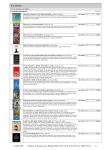

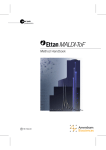

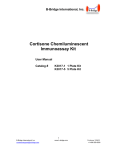
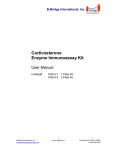
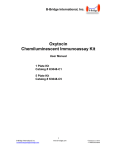

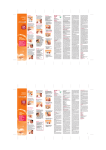
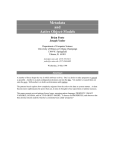
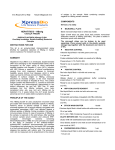
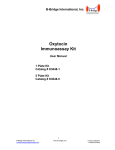
![TEMPLATE No1 [CPMP positive opinion full application]](http://vs1.manualzilla.com/store/data/005681628_1-1a3acb54fcca990dd8c826546eb4788f-150x150.png)
